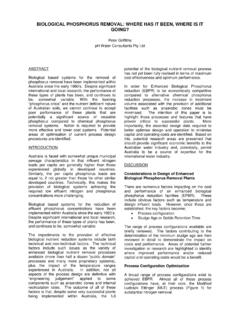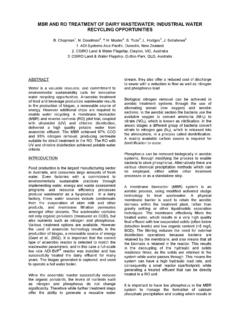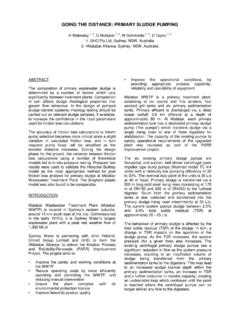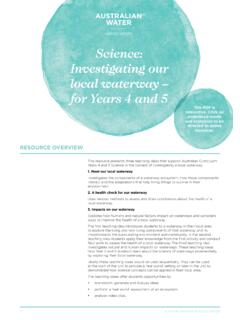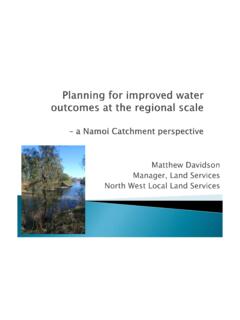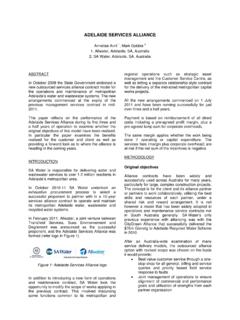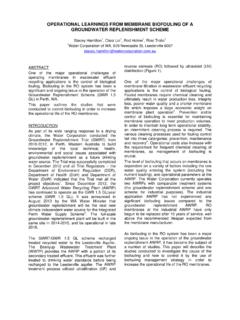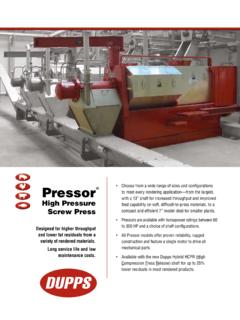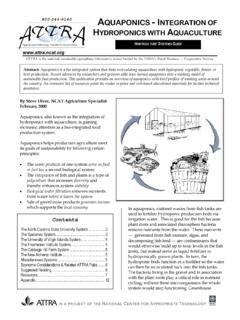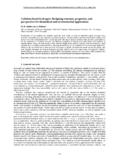Transcription of LOW OPERATING COST WASTEWATER …
1 LOW OPERATING cost WASTEWATER treatment technologies FOR RED MEAT AND OTHER INDUSTRIES Mitchell Laginestra 1 1. GHD Pty Ltd, Adelaide, SA ABSTRACT The cost of treating WASTEWATER from red meat processing and other high organic wastewaters is increasing with more stringent environmental discharge requirements and rising power costs. Red meat WASTEWATER contains high concentrations of contaminants which necessitates a multiple treatment processes to meet environmental quality criteria. A typical treatment system for the industry involves anaerobic process followed by aerated lagoon or activated sludge variants to provide suitable effluent quality.
2 The two key shortcomings of the systems involve footprint and high power and annual costs. While capital cost is a main driver, more simple processes with lower annual operational costs are seen as significantly advantageous. The focus of this paper is the advent of anaerobic lagoons and trickling filtration process. Although regarded by some critics as low technology or outdated, these processes have the ability to minimise capital and annual costs, and reduce greenhouse gas emissions. The paper includes a presentation of criteria and reviews technology applications for the industry and presents a cost comparison.
3 INTRODUCTION The cost of treating WASTEWATER from red meat processing and other high organic wastewaters is increasing with environmental discharge requirements and rising power costs. Red meat WASTEWATER has high contaminant concentrations (refer Table 1), typically loaded with solids, floatable matter (fat), blood, manure and a variety of organic compounds and which necessitates a multiple process treatment train. A typical treatment system involves anaerobic systems (long detention time but minimal OPERATING costs) followed by activated sludge variants (relatively short detention time, but high power cost system) to provide suitable effluent quality.
4 While capital cost is a key driver, more simple processes with lower annual operational costs are seen as significantly advantageous by operators. To that end, covered anaerobic lagoons and trickling filtration are regarded as appropriate for meat industry WASTEWATER treatment . Although regarded by some critics as low technology or outdated, these processes have the ability to minimise capital and annual costs, while at the same time generating energy and reducing greenhouse gas emissions respectively. REVIEW OF technologies There are a number of technologies that are applied to WASTEWATER treatment at meat processing plants.
5 treatment typically involves a multiple process train: Physical or primary treatment for solids and grease removal, typically involving Dissolved Air Flotation (DAF), and screening; Biological or secondary treatment to reduce the bulk of the BOD comprising: o Anaerobic digestion (lagoons are most common in USA and Australia, but constructed reactors have also been used, although mainly in Europe) o Aerobic treatment downstream of anaerobic systems typically activated sludge, waste stabilisation ponds or aerated lagoons. Anaerobic treatment is popular as a first stage of biological treatment of abattoir WASTEWATER and considered to be well suited to abattoir WASTEWATER .
6 It is noted that lagoons are more popular in the USA and Australia, since climate conditions and land availability allow the construction of large lagoons. However, many are uncovered (due to cost limitations). Covering of these lagoons provides a number of benefits, such as: Opportunity to control odours. Capture of greenhouse gases. Ability to use biogas to generate electrical energy and thus minimise the carbon footprint of the facility. Downstream of anaerobic ponds, aerobic systems are required to control odours and reduce BOD to acceptable levels and so enable environmental discharge.
7 In most countries ponds remain the most common form of aerobic treatment for removal of COD from WASTEWATER . However, a wide array of mechanical systems, including activated sludge systems (more common) and trickling filters have been used. The main advantage of the pond systems is their simplicity to build and operate, although their non-mechanical aspect means a greater volume (and subsequently area / footprint) is required to treat WASTEWATER than conventional (mechanical) treatment systems. Over the past 30 + years, trickling filters have largely been replaced by activated sludge processes in municipal and industrial WASTEWATER treatment .
8 Although involving significantly lower running costs and operational simplicity compared to activated sludge systems, they are often regarded as old technology. However, the advent of plastic support media in lieu of older stone type, has allowed increased height and loading capability and enhanced ability to nitrify, which could change perceptions. DESIGN CONSIDERATIONS TF VERSUS AS It should be noted that while activated sludge is the most widely used secondary biological treatment system for most wastewaters around the world, key drawbacks are the potential for sludge bulking, excess sludge production and demanding operations and maintenance requirements (particularly where load is constantly changing, as in processing days in industrial applications).
9 Advantages of trickling filters are the low energy usage compared to activated sludge, as well as reduced complexity and sludge production. In addition, fixed film systems (TF s) are less susceptible to toxicity and shock loads than activated sludge systems. Trickling filters have traditionally taken up more land. With the high rate plastic media trickling filter process, this is no longer the case. Because of the high concentration of biomass attached to the media surface area, the reactors can handle higher loads per unit volume than activated sludge.
10 Effluent quality is not regarded to be equal to that of the conventional activated sludge process, however, trickling filtration can provide a very good effluent quality and the process is capable of significant removal of pollutants (including COD, ammonia-nitrogen, oil and grease). In addition, if total nitrogen reduction was required then some activated sludge system may be applicable downstream of the trickling filter. Combined systems provide a robust process, with minimised energy use and enhanced effluent quality, and have been adopted at a number of municipal and industrial applications in Australia and USA.
